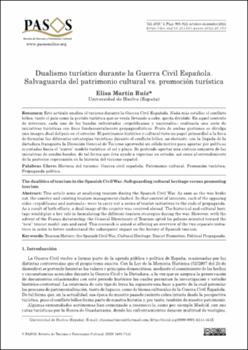Dualismo turístico durante la Guerra Civil Española. Salvaguarda del patrimonio cultural vs. promoción turística
Author
Martín Ruiz, ElisaDate
2022Abstract
Este artículo analiza el turismo durante la Guerra Civil Española. Nada más estallar el conflicto
bélico, tanto el país como la gestión turística que se venía llevando a cabo, queda dividido. En aquel contexto
de intereses, cada uno de los bandos enfrentados –republicanos y nacionales– realizaría una serie de
iniciativas turísticas con fines fundamentalmente propagandísticos. Fruto de ambas gestiones se divulga
una imagen dual del país en el exterior. El patrimonio histórico y cultural tuvo un papel primordial a la hora
de formular las diferentes estrategias turísticas durante el conflicto bélico, no obstante, con la llegada de la
dictadura franquista la Dirección General de Turismo aprovechó un sólido motivo para apostar por políticas
orientadas hacia el “nuevo” modelo turístico: el sol y playa. Se pretende aportar una síntesis conjunta de las
iniciativas de sendos bandos, de tal forma que ésta ayude a vigorizar su estudio, así como al entendimiento
de la posterior repercusión en la historia del turismo español. This article aims at analysing tourism during the Spanish Civil War. As soon as the war broke
out, the country and existing tourism management clashed. In that context of interests, each of the opposing
sides –republicans and nationals– were to carry out a series of tourist initiatives to the ends of propaganda.
As a result of both efforts, a dual image of the country was received abroad. The historical and cultural heri‐
tage would play a key role in formulating the different tourism strategies during the war. However, with the
advent of the Franco dictatorship, the General Directorate of Tourism opted for policies oriented toward the
“new” tourist model: sun and sand. This research is aimed at offering an overview of the two separate initia‐
tives in order to better understand the subsequent impact on the history of Spanish tourism.





